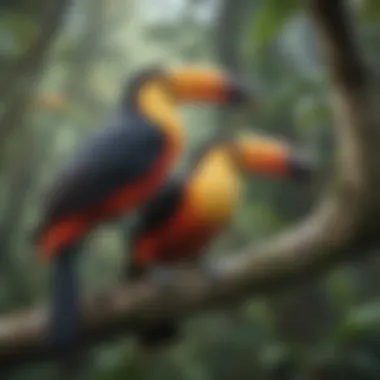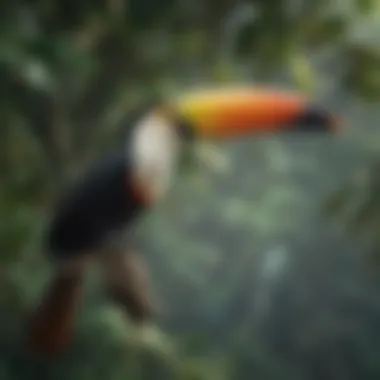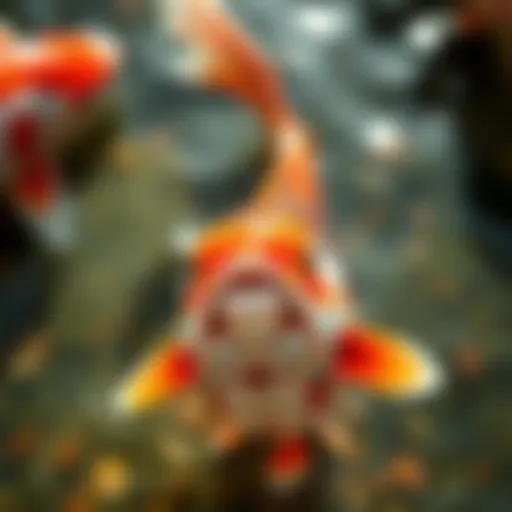Unveiling the Enchanting World of Toucan Birds Through Their Vibrant Colors and Distinctive Beaks


Animal Species Profile
Toucan birds have long been revered for their striking appearance and unique characteristics. With vibrant colors adorning their feathers and their iconic, large beaks, these avian creatures never fail to captivate onlookers.
Toucans are predominantly found in the lush rainforests of Central and South America, showcasing a preference for habitats abundant with fruit-bearing trees. Their distribution spans from Mexico to Argentina, where they navigate the dense canopies with remarkable agility and grace.
In terms of behavior, toucans are known for their social interactions within their flocks. They exhibit strong familial bonds and engage in playful activities, such as mock-fighting and communal roosting, contributing to a rich tapestry of avian behaviors.
Conservation & Wildlife Efforts
The conservation status of toucan species varies across different regions, with some facing significant threats due to habitat loss, deforestation, and illegal wildlife trade. Organizations like World Wildlife Fund and Rainforest Trust have been pivotal in spearheading conservation initiatives focused on preserving toucan habitats and combatting detrimental practices.
Despite the challenges, there have been success stories in the realm of toucan conservation. Through collaborative efforts and community involvement, these organizations have made strides in protecting toucan populations and raising awareness about the importance of biodiversity.
Animal Behavior & Psychology
Toucans employ a diverse array of communication cues, including vocalizations, body postures, and even color displays from their iconic beaks. Their reproductive behavior involves intricate courtship rituals and cooperative parenting, highlighting their complex social structure within the flock.
In addition to their social behaviors, toucans exhibit remarkable cognitive abilities and problem-solving skills, enabling them to navigate their dynamic rainforest environment with precision and adaptability. Their emotional intelligence is reflected in their interactions with flock members, displaying empathy and cooperation.
Unique Facts & Trivia
Delving into the realm of toucan trivia unveils fascinating facts about these birds. Did you know that toucans have zygodactyl feet, with two toes facing forward and two facing backward, providing exceptional gripping capabilities? Their beaks, while visually stunning, are surprisingly lightweight, composed mainly of keratin, the same material found in human hair.
Toucans are also known for their playful nature, engaging in aerial acrobatics and tossing fruits in a display of dexterity. With their keen eyesight and keen sense of hearing, they excel in detecting fruit in the canopy, showcasing their adaptability and resourcefulness.
Pet Care & Tips
For individuals considering toucans as pets, it is essential to understand their unique needs and requirements. Due to their energetic nature and sizable beaks, toucans thrive in spacious aviaries equipped with ample room for flight and play. Their diet primarily consists of fresh fruits like papaya and berries, supplemented with proteins such as insects and small reptiles.
Ensuring the physical and mental well-being of pet toucans involves providing opportunities for enrichment, such as puzzle feeders and foraging activities. Regular veterinary check-ups are crucial to monitor their health, with a focus on avian nutrition and preventative care to promote longevity and quality of life.
Introduction to Toucan Bird
Toucan birds, with their vibrant colors and unique beaks, captivate the imagination of all who behold them, embodying elegance and exotic beauty in the avian world. This section serves as a gateway to understanding the multifaceted world of these remarkable creatures, providing insight into their significance not only in the realm of ornithology but also in ecological diversity. Exploring the characteristics, habitats, behaviors, and conservation status of toucans offers a holistic view of their role in nature's tapestry, making this topic a crucial focal point in unraveling the enigma of these avian wonders. By delving into the nuances of toucan biology and lifestyle, we illuminate intricacies that illuminate why toucans are revered by wildlife enthusiasts and researchers alike.


Overview of Toucan Birds
Species Diversity
Diving into the realm of species diversity among toucan birds reveals a spectrum of unique adaptations and evolutionary pathways that set these avian species apart. The array of colors, sizes, and habits among different toucan species showcase the marvels of nature's evolutionary craftsmanship. Each subspecies brings a distinct element to the overall toucan family, enriching the tapestry of avian biodiversity. By exploring the nuances of species diversity in toucans, we unravel the intricate web of genetic variations that underscore their resilience and adaptability in diverse habitats.
Morphological Features
Intriguingly, the morphological features of toucans encompass an array of adaptations finely tuned to their ecological niches. From their iconic oversized beaks to their vibrant plumage, toucans epitomize nature's creativity in form and function. Each morphological trait serves a specific purpose, be it for foraging, communication, or camouflage. Understanding the significance of these features sheds light on the evolutionary trajectory of toucans and the complexities of their interactions with the environment.
Ecological Importance
The ecological importance of toucan birds transcends mere aesthetics, delving into their roles as seed dispersers, pollinators, and indicators of ecosystem health. Their presence in diverse habitats signifies a balanced ecosystem where these avian ambassadors thrive. By elucidating the ecological contributions of toucans, we gain a deeper appreciation for their interconnectedness with flora, fauna, and environmental processes. Studying their ecological importance unveils the intricate web of dependencies that underscore the fragility and resilience of ecosystems that toucans inhabit.
Historical Significance
Ancient Cultural Depictions
The historical significance of toucans reverberates through ancient cultural depictions, where these birds symbolize vitality, resilience, and grace in various folklore and traditions. From Mayan civilizations to modern indigenous cultures, toucans have left a lasting impression on human creativity and symbolism. Exploring the ancient cultural depictions of toucans unravels a tapestry of human-animal relationships, highlighting the enduring appeal of these avian wonders across diverse cultures and epochs.
Evolutionary History
The evolutionary history of toucans offers a glimpse into their journey through time, tracing their origins, adaptations, and survival strategies across epochs. By examining the fossil record and genetic markers, researchers unravel the intricate puzzle of toucan evolution, shedding light on the forces that shaped their diverse traits and ecological roles. Exploring the evolutionary history of toucans unveils a saga of resilience, adaptation, and coevolution that positions these birds as living testaments to the wonder of natural selection and biological diversity.
Distinctive Characteristics of Toucans
In understanding the world of toucan birds, delving into their remarkable distinctive characteristics becomes imperative. These avian creatures are renowned for their vibrant plumage and iconic beaks, setting them apart from other avian species. Their striking appearance not only captivates onlookers but also serves essential functions in their ecological niche. The vivid colors of their plumage and the unique shape of their beaks play crucial roles in their survival strategies, mating rituals, and ecosystem interactions. By exploring the distinctive characteristics of toucans, we can unravel the intricate balance of nature's design and the adaptation strategies that have evolved over time.
Vibrant Plumage and Beak
Color Variations
Across the spectrum of color variations exhibited by toucans, each hue serves a specific purpose in their lives. From vibrant reds to deep blues, these colors are not merely decorative but act as signals for behaviors such as territory marking, mate selection, and warning signs. The intense brightness of their plumage aids in camouflaging within the dense foliage of the rainforest, offering them protection from predators and enabling effective communication with their flock members. Understanding the importance of color variations in toucans provides insights into the evolutionary pressures that have sculpted their visual appearance into a masterpiece of both artistry and functionality.
Beak Adaptations
The beak of toucans is a marvel of adaptations tailored to their specific feeding habits and survival needs. Its notable elongation and vibrant colors are not just for show but serve diverse purposes. The large, lightweight structure of their beaks allows for efficient foraging in the treetops, reaching fruits that are otherwise inaccessible to other birds. Moreover, the vivid hues of their beaks are a result of intricate biochemistry that aids in thermoregulation, providing a unique advantage in the tropical environments they inhabit. Exploring the intricacies of beak adaptations in toucans unveils a world of evolutionary specialization and ecological symbiosis that showcases nature's unparalleled ingenuity.


Physical Features
Size and Shape
The size and shape of toucans play a vital role in their overall physiology and behavioral patterns. With their compact yet robust bodies, toucans navigate the canopy with ease, utilizing their size to maneuver through dense vegetation effortlessly. Additionally, their distinct body shape allows for swift flight and precise navigation within the intricate network of branches in their habitat. Understanding the significance of size and shape in toucans sheds light on the evolutionary pressures that have shaped their form and function, highlighting the remarkable adaptations that have enabled their survival in challenging rainforest environments.
Feather Structure
The feather structure of toucans is a marvel of engineering, providing not just insulation and protection but also enhancing their aerodynamic capabilities. Each feather is meticulously designed to offer optimal lift and maneuverability during flight, allowing toucans to soar through the forest canopy with grace and agility. Moreover, the vibrant colors and unique patterning of their feathers serve as visual cues for communication and species recognition, further underscoring the importance of feather structure in their social dynamics and ecological interactions. Exploring the intricate details of feather structure in toucans unveils a world of precision engineering and evolutionary advancement that showcases the elegance and effectiveness of nature's design principles.
Habitat and Distribution of Toucan Birds
The exploration of the habitat and distribution of Toucan birds introduces us to the fundamental aspects dictating their survival and behavior in the wild. Understanding this context is crucial to appreciating the intricacies of these avian creatures. Toucans primarily inhabit vibrant and diverse ecosystems, playing a vital role in their respective environments.
Natural Habitat
Rainforest Ecosystems
Rainforest ecosystems serve as the primary abode for these majestic birds, offering a rich tapestry of biodiversity for them to thrive in. The lush canopy provides ample opportunities for these birds to showcase their aerial acrobatics and vibrant plumage against the verdant backdrop. The intricate interplay between flora and fauna in these ecosystems underscores the essential role Toucans play in seed dispersal and ecosystem balance. However, the challenges of rapid deforestation and habitat fragmentation pose significant threats to their existence in these paramount ecosystems.
Tree Canopy Dwellers
As adept tree canopy dwellers, Toucans navigate the intricate networks of branches and foliage, utilizing their unique beak adaptations to forage for food and communicate with their counterparts. Their choice to dwell in the upper reaches of trees not only provides them with strategic vantage points but also aids in evading potential predators. Despite the advantages offered by this high-altitude living, Toucans face risks such as nest predation and limited foraging opportunities due to human interference and habitat degradation.
Geographical Range
Tropical Regions
Toucans predominantly inhabit tropical regions characterized by warm climates and abundant rainfall, fostering the lush environments they call home. The intricate relationship between Toucans and these tropical locales is symbiotic, as these birds rely on the year-round fruiting cycles of trees for sustenance. Within this setting, Toucans fulfill pivotal ecological roles by aiding in seed dispersal and contributing to the overall health of the ecosystem. However, factors like climate change and deforestation pose significant challenges to these delicate ecological balances.
Specific Countries
Across specific countries in Central and South America, Toucans establish their presence amidst the unique biodiversity and varied landscapes each nation offers. From the dense Amazon rainforests to the coastal regions of Colombia, these birds adapt to diverse habitats, showcasing their resilience and adaptability. The presence of Toucans in these countries signifies not just their geographical range but also underscores the cultural significance these birds hold for local communities. Nevertheless, the threats of habitat loss and illegal wildlife trade threaten to disrupt this intricate tapestry of avian diversity within these regions, calling for vigilant conservation efforts and community engagement.
Behavioral Patterns of Toucans
Exploring the behavioral patterns of Toucans is crucial in understanding the intricate social dynamics and survival strategies of these fascinating creatures. Toucans exhibit a variety of behaviors that are essential for their daily lives, such as foraging, mating rituals, and territorial defense. By delving into the behavioral patterns of Toucans, we gain valuable insights into how they interact with their environment and other Toucans.


Toucans have developed unique feeding habits that play a significant role in their survival. Fruit consumption is a key aspect of their diet, as they rely heavily on a variety of fruits found in their tropical habitats. This dietary choice not only provides essential nutrients but also contributes to seed dispersal, making Toucans vital for the ecosystem's health. Their efficient digestion process allows them to extract maximum nutrition from the fruits they consume, showcasing their adaptation to their environment.
Hunting techniques among Toucans vary based on their prey preferences. Despite being primarily fruit-eaters, some Toucan species also engage in insect hunting or scavenging. Their hunting techniques often involve agile movements and precise beak strikes to capture prey efficiently. By exploring the hunting techniques of Toucans, we uncover their adaptability and resourcefulness in obtaining food beyond just fruits. This diversity in hunting behavior reflects the Toucans' flexibility in surviving in diverse environments.
Social interactions play a significant role in Toucan communities, influencing behavior and group dynamics. Group dynamics within Toucan flocks are intriguing, with hierarchies forming based on factors like age and dominance. Understanding the intricate balance of interactions within Toucan groups sheds light on their social structures and cooperative behaviors. Through mutual communication and sharing of resources within the group, Toucans exhibit a cooperative nature that enhances their chances of survival.
Communication methods among Toucans involve a combination of vocalizations, body language, and visual cues. These methods are essential for conveying messages related to territory, mating, and alerting others to potential threats. By dissecting the nuances of Toucan communication, we uncover the complexity of their social interactions and cooperative behaviors. These communication methods are vital for maintaining group cohesion and ensuring efficient responses to environmental stimuli. Overall, the behavioral patterns of Toucans showcase a rich tapestry of social behaviors and adaptive strategies that highlight their uniqueness and ecological significance.
Conservation Status and Thraets
Conservation Status and Th resorting to illegal means. Describe in detail the specific challenges faced by toucan populations regarding
- Habitat Loss Habitat loss poses a significant threat to toucan populations, as deforestation and land degradation result in the destruction of essential habitats for these majestic birds. The encroachment of human activities into natural forests leads to a loss of nesting sites, food sources, and protection from predators, critically impacting toucans' survival. Additionally, the fragmentation of forests hinders toucans' ability to move between areas, limiting their breeding and foraging opportunities, further jeopardizing their populations. The consequences of habitat loss extend beyond the immediate loss of individuals and species and impact entire ecosystems, altering biodiversity and ecological balance.
- Illegal Wildlife Trade The illegal wildlife trade presents a grave concern for toucan populations, as these birds are sought after for their stunning appearance, including their colorful plumage and unique beaks. Poaching and trafficking of toucans occur to meet the demand for exotic pets, decorations, and traditional medicines, driving populations towards decline. Toucans captured for the illegal trade often suffer from stress, injuries, and inadequate care, leading to high mortality rates. The exploitation of toucans not only disrupts their natural behaviors and habitats but also contributes to the decimation of wild populations. Combatting illegal wildlife trade requires collaborative efforts from law enforcement agencies, conservation organizations, and local communities to enforce regulations and educate on the importance of protecting these vulnerable species.
Conservation Efforts
Conservation Eff within their natural habitats
- Protected Areas Establishing protected areas plays a crucial role in conserving toucan populations by safeguarding their habitats, reducing human-induced disturbances, and promoting sustainable land use practices. Protected areas offer refuge to toucans by creating safe zones where they can breed, feed, and thrive without the threat of habitat destruction or exploitation. These areas also support the conservation of other wildlife species, contributing to overall biodiversity conservation and ecosystem stability. However, the effectiveness of protected areas relies on adequate management, monitoring, and community involvement to address external threats such as poaching, logging, and agricultural encroachment.
- Community Initiatives Community initiatives are key components of conservation efforts for toucans, as local communities play a vital role in protecting these birds and their habitats. Engaging with communities residing near toucan habitats fosters greater awareness, support, and participation in conservation activities, promoting sustainable practices and reducing human-wildlife conflicts. Collaborating with local stakeholders to develop ecotourism programs, habitat restoration projects, and educational campaigns empowers communities to become stewards of toucan conservation. By integrating traditional knowledge with modern conservation strategies, community initiatives enhance long-term conservation outcomes and foster a sense of ownership and responsibility toward protecting toucans and their environments.
Fascinating Facts About Toucan Birds
Toucan birds, with their captivating allure and distinctive features, hold a special place in the world of avian enthusiasts 🦜. In this section, we'll unravel intriguing details about these charismatic creatures that bring joy to many wildlife admirers. Understanding the quirks and peculiarities of Toucans not only enriches our knowledge but also fosters a deeper appreciation for these feathered wonders 🌿. Let's embark on a journey 🌍 through the fascinating world of Toucan birds to uncover some hidden gems about their existence.
MythBusting Misconceptions
Eating Habits
Toucan birds have long been portrayed as avid fruit eaters 🍎, but the reality goes beyond this common perception. Delving into the realm of their eating habits unveils a diverse palette of preferences, ranging from fruits to insects and even small reptiles. Contrary to popular belief, Toucans exhibit a versatile diet that adapts to their surroundings and seasonal availability 🦗. This flexibility in food choice underscores their resilience and adaptability in various ecosystems where they thrive.
Flight Abilities
The flight abilities of Toucan birds 🕊️ surpass mere transportation from one point to another. Their unique aerodynamic features allow for efficient maneuvering through dense rainforest canopies and swift escapes from predators. Despite their seemingly large and vibrant beaks, Toucans boast remarkable agility in the air, showcasing a mastery of flight that complements their arboreal lifestyle 🌳. Understanding the intricacies of their flight prowess sheds light on the evolutionary adaptations that have honed these birds into graceful aerial navigators.
Unique Adaptations
Feather Functions
Feathers play a crucial role in the lives of Toucan birds, far beyond aesthetic appeal 🎨. The intricate design of their feathers serves a myriad of functions, from insulation and waterproofing to communication and camouflage. Each feather type possesses distinct properties tailored to specific needs, enabling Toucans to thrive in diverse environments 🏞️. Exploring the functional significance of their feathers unravels a tapestry of evolutionary adaptations that have sculpted these birds into avian marvels.
Beak Development
The evolution of the iconic beak in Toucan birds is a testimony to the marvels of nature's design 🌟. Beyond its striking appearance, the beak embodies a multifaceted tool essential for their survival. From foraging and feeding to thermoregulation and even courtship displays, the beak of a Toucan serves as a Swiss army knife of functionalities 🍴. Unpacking the stages of beak development sheds light on the intricate processes that have shaped this defining feature, showcasing the innovative solutions nature has crafted for these remarkable avian beings.







